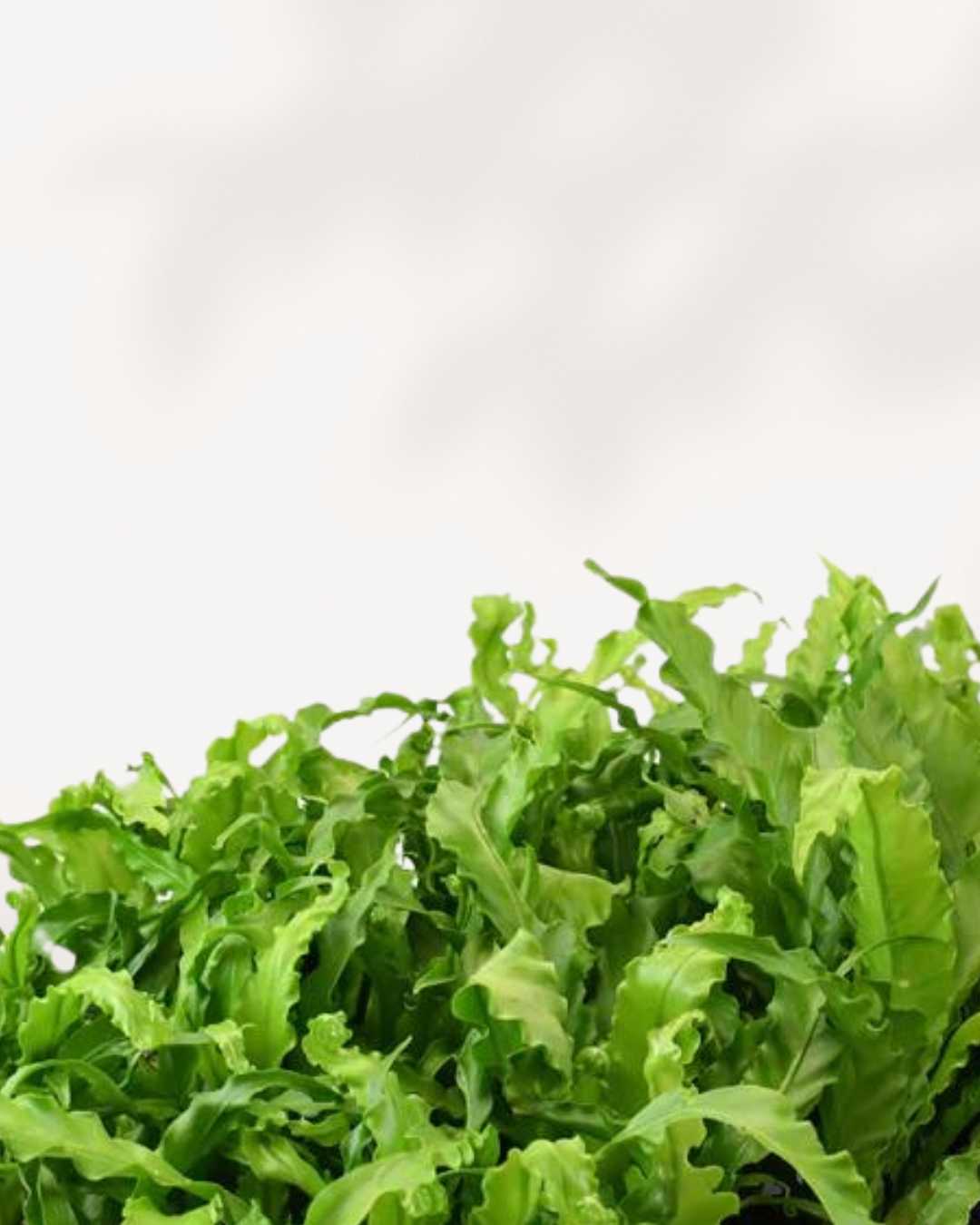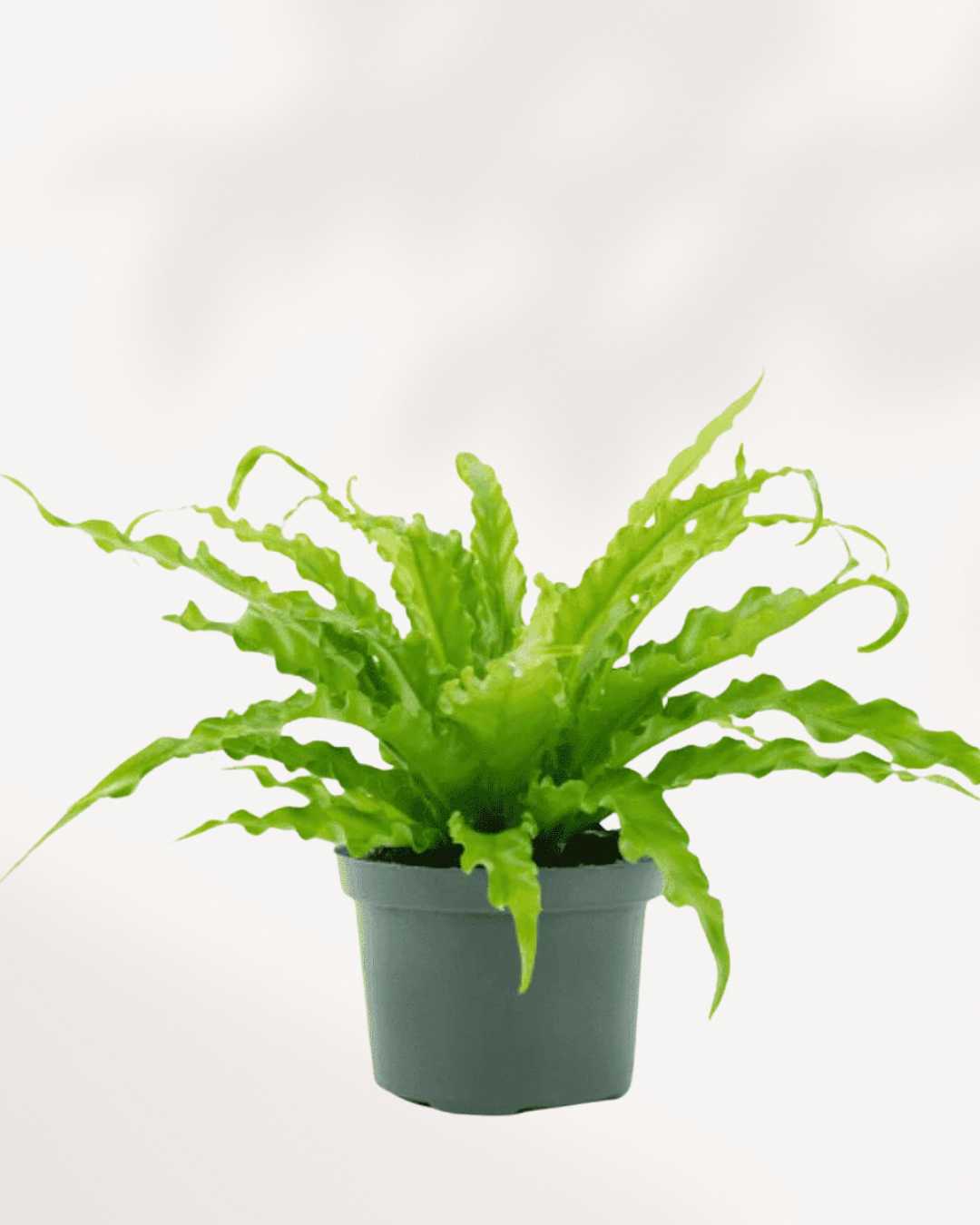Couldn't load pickup availability
Bird's Nest Fern, also known as Asplenium nidus, is a popular tropical houseplant admired for its wavy, bright green fronds that grow in a rosette shape. Its elegant and structured appearance makes it a perfect addition to modern indoor spaces and shaded gardens.
Common Names
- Bird's Nest Fern
- Asplenium Fern
- Nest Fern
Botanical Classification
- Kingdom: Plantae
- Order: Polypodiales
- Family: Aspleniaceae
- Genus: Asplenium
- Species: Asplenium nidus
Native Habitat
Bird's Nest Fern is native to the tropical forests of Southeast Asia, Australia, and the Pacific Islands. It grows naturally as an epiphyte, often found on tree trunks and branches, thriving in warm and humid environments.
Historical and Cultural Significance
The Bird's Nest Fern is widely regarded as a symbol of resilience and longevity. Its lush, evergreen foliage represents growth and harmony, making it a cherished plant in tropical-themed decor and feng shui practices.
Uses and Popularity
Bird's Nest Fern is valued for its ornamental beauty and low-maintenance care. Its arching, wavy leaves make it a stunning focal point in living rooms, bathrooms, and shaded patios. It is also considered pet-friendly, adding to its popularity in households with animals.
Conservation Status
Bird's Nest Fern is not endangered and is widely propagated in nurseries, ensuring its availability for plant enthusiasts worldwide.
Description
Physical Characteristics
Bird's Nest Fern features bright green, sword-shaped fronds that emerge in a circular, nest-like pattern. The fronds can grow up to 2-3 feet in length, creating a full, bushy appearance. Its glossy leaves and wavy edges add texture and elegance.
Growth Habit
This fern has a slow to moderate growth rate and maintains a compact, upright form. Indoors, it can reach a height of 2-3 feet (60-90 cm) with proper care. It thrives in humid environments, making it ideal for bathrooms and kitchens.
Popular Fern Varieties
Crispy Wave Fern
- Recognized for its ruffled, compact leaves that filter toxins from the air.
Boston Fern
- Features feathery, arching fronds, perfect for hanging baskets.
Asparagus Fern
- Graceful, needle-like foliage ideal for cascading arrangements.
Staghorn Fern
- Unique, antler-shaped fronds that can be mounted as wall art.
Care Guide
Light Requirements
Bird's Nest Fern thrives in bright, indirect light but can tolerate low light conditions. Avoid direct sunlight, as it can scorch the leaves.
Watering Needs
Keep the soil consistently moist but not waterlogged. Water when the top inch of soil feels dry. Avoid watering directly into the rosette, as it can cause rot. Indoor Plant Watering
Soil Preferences
Use a well-draining, rich potting mix with added organic matter. Slightly acidic soil with good aeration is ideal for this fern. Indoor Potting Mix
Humidity
Prefers high humidity levels (50-80%). Use a humidifier, mist regularly, or place near a pebble tray to maintain moisture.
Common Pests
Mealybugs
Mealybugs appear as white, cottony masses. Remove them with rubbing alcohol or insecticidal soap. Learn More
Scale Insects
Small, brown bumps on leaves or stems. Treat with neem oil or insecticidal soap.
Fungus Gnats
Can thrive in overly moist soil. Let the soil dry slightly and use sticky traps. Learn More
FAQs
Why are my Bird's Nest Fern leaves turning yellow?
Yellow leaves may indicate overwatering or poor drainage. Check soil moisture and repot if necessary.
Is Bird's Nest Fern pet-friendly?
Yes, this fern is non-toxic to cats and dogs, making it a safe choice for pet owners.
Can Bird's Nest Fern grow in low light?
Yes, it can tolerate low light, but bright, indirect light is preferred for optimal growth.
How often should I fertilize?
Feed with a balanced, liquid fertilizer every 4-6 weeks during the growing season. Reduce feeding in winter.
How to take care of Birds Nest Fern Plant
Sun: Indirect
Sun: Indirect
Light: Medium - Bright
Light: Medium - Bright
Water: When half dry
Water: When half dry
Humidity: High
Humidity: High
Pet Friendly: Yes
Pet Friendly: Yes
Pro Tip
Pro Tip
Delivery Policy for Plant Condition
Delivery Policy for Plant Condition
"I have only received part of my order. What to do?
No worries if you've only got part of your order! Our plants come from different nurseries and might arrive in separate shipments, typically 1-2 days apart. It's all part of ensuring your green friends reach you in top-notch condition!
If you do not receive the remaining packages within 48 hours contact support at info@mygreenscape.ca
What is the Life Time Support?
Absolutely! Lifetime support means you can count on us whenever you have questions or uncertainties about your plant. Whether you're puzzled by its behavior or just want to ensure it's thriving, we're here for you. Connect with us on Instagram @mygreenscapeto or shoot us an email at support@mygreenscape.ca.
When it comes to our guarantee for plants shipped with standard or express, rest assured that we offer a 30-day happy healthy plant guarantee on all such shipments. This ensures that your plants are covered for 30 days after delivery, giving you peace of mind regarding their condition. If you have any concerns within this period, feel free to reach out to us for assistance.
For further details, please visit our Local Delivery, Store Pickup, Standard Shipping Guide Page.
What to expect
What to expect
Your plant will arrive in a standard nursery pot, typically 0.5" - 1" smaller than the stated size to seamlessly fit into your chosen decorative pot. Washable Paper Planter Bags are available for separate purchase.
Just like nature intended, each plant is unique, showcasing natural variations in size, shape, and characteristics. Our commitment is to deliver a plant that closely resembles the one featured on our website, matching your chosen size, and with the potential to thrive happily in your home.
Frequently Asked Questions
Frequently Asked Questions
Certainly! If you're pondering about ordering plants online, you're not alone. We've compiled the most frequently asked questions. Check out our FAQ section here for quick answers! Happy planting!
Plant & Pot Size Chart
Plant & Pot Size Chart
Choosing the right pot size for your plants can be a daunting task, especially if you're new to gardening. But fear not! Our pot sizes chart can help you find the perfect match for your plants, ensuring they have enough space to grow and thrive. With our guide, you'll be able to confidently choose the right pot size and plant variety for your gardening needs.
Plant Pot Size Guide.

| Extra Small | 7-10 cm | 2.5 - 3 inches |
| Small | 11-12 cm | 3.5 - 4 inches |
| Medium | 14-17 cm | 5 - 6 inches |
| Large | 19-21 cm | 8 - 10 inches |
| Extra Large | 24-27 cm | 12 - 14 inches |
All sizes are specified in product details.
Your Complete Guide to Pot Sizes: What Size Should You Choose?

When selecting a pot for your plant, it's important to find the right size. But with all the different options out there, how do you know which one is best? We're here to help!
MyGreenscape's pot sizes chart is a great resource for finding your perfect fit. Our easy-to-read chart takes out all the guesswork and helps you quickly choose the right size for your plant.
Smaller pots are best for seedlings or small plants just starting out. These tend to be shallow but wide, allowing enough room for the roots of the young plant but not too much where they get overcrowded. Medium-sized pots are ideal when your plant has grown from its infancy and is ready for more space. These are deeper and wider than small pots, so that it can accommodate larger root systems - making sure your plant gets enough nourishment while still giving it breathing room. Large pots are top choice if you have an established plant in need of lots of space - think trees and large shrubs! The spacious depth and width allow plenty of room for deep root systems without struggling for air or light.
No matter what size you choose, MyGreenscape has got you covered, with our pot sizes chart guaranteeing you find the perfect fit every time!
Winter Shipping Protection
Winter Shipping Protection
We take extra care with each package during the colder months. For destinations experiencing cold weather, we provide insulated packaging and heat packs as needed to protect your plants from freezing temperatures. With Winter Shipping Protection, your plants are equipped to arrive safe and sound, even in winter’s chill.
Care Guide
Care Guide
Explore essential care tips. check out our Comprehensive Resource for Indoor Plant Care.



WATERING MADE EASY
Check soil moisture before watering and use a potting mix that drains well. It’s the secret to healthy, happy plants!
Hear From Happy Plant Parents.
Who have brought Mygreenscape plants into their homes.
















